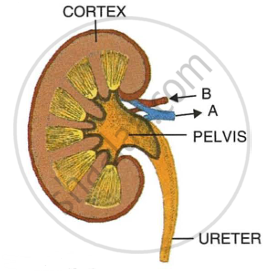Advertisements
Advertisements
प्रश्न
Given below is a simplified diagram of the human kidney cut open longitudinally. Answer the questions that follow.
 |
- Define excretion.
- Why does the cortex of the kidney show a dotted appearance?
- Why does the medulla of the kidney show a striped appearance?
- Write two differences in the composition of the blood flowing through the blood vessels 'A' and 'B'.
उत्तर
- The process of removal of chemical wastes (mainly nitrogenous wastes) from the body is known as 'excretion'.
- Due to both Bowman's capsule and the proximal convoluted part lying in it.
- Henle's loops and collecting ducts in the medulla of the kidneys create a striped or striated look.
-
- Renal Artery: The blood vessel 'B', i.e., the renal artery, contains dirty blood.
Renal Vein: The blood vessel 'A', i.e., the renal vein, contains cleaned blood. - Renal Artery: It pours the blood into the glomerulus and Bowman's capsule.
Renal Vein: It pours blood into the postvena cava. Blood arteries A and B open into the medulla, not the pelvis or ureter.
- Renal Artery: The blood vessel 'B', i.e., the renal artery, contains dirty blood.
APPEARS IN
संबंधित प्रश्न
Where is the dirty blood in our body filtered?
What is the role of glomerulus in the kidney?
How are waste products excreted in Amoeba?
If a patient is out on dialysis, he is most likely suffering from a severe ailment of the:
(a) circulatory system
(b) respiratory system
(c) excretory system
(d) digestive system
The organs A of a person have been damaged completely due to which too much of a poisonous waste material B has started accumulating in his blood, making it dirty. In order to save this person's life, the blood from an artery in the person's arm is made to flow into long tubes made of substance E which are kept in coiled form in a tank containing solution F. This solution contains three materials G, H and I in similar proportions to those in normal blood. As the person's blood passes through long tubes of substance E, most of the wastes present in it go into solution. The clean blood is then put back into a vein in the arm of the person for circulation.
(a) What are organs A?
(b) Name the waste substance B.
(c) What are (i) E, and (ii) F?
(d) Name G, H and I.
(e) What is the process described above known as?
Differentiate between the following pairs of term :
Renal pelvis and renal papilla
Define the following term:
Osmoregulation
Give Technical Term:
The tube joining the kidney to the urinary bladder.
Choose the Odd One Out:
The process of diffusion of solvent particles from the region of less solute concentration to a region of high solute concentration through a semi-permeable membrane is known as ____________.
